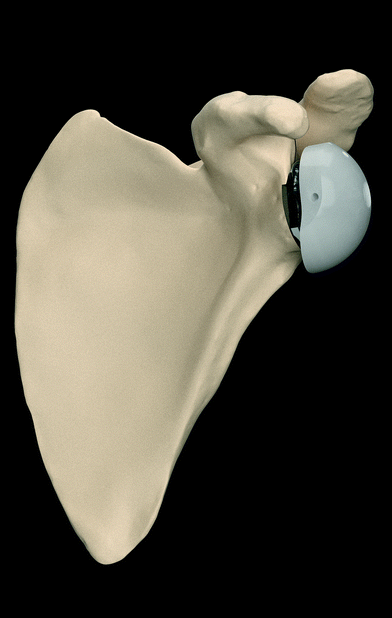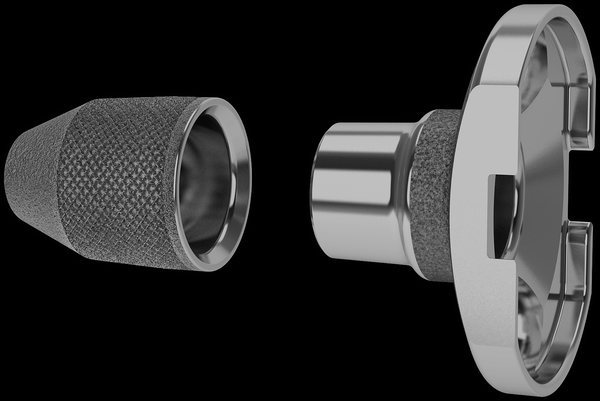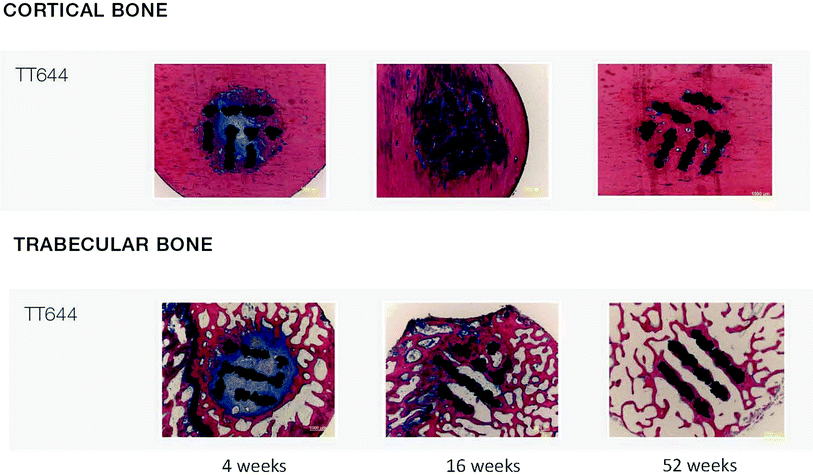Fig. 41.1
SMR reverse total shoulder arthroplasty
Design Concepts
The patient’s joint must be anatomically and structurally suited to receive the selected implants, and a functional deltoid muscle is necessary to use the device. The SMR Reverse Shoulder System was designed starting from specific design purposes. A critical review of the literature was also performed to identify the main issues reported in association with the use of reverse shoulder systems: These issues have been considered as a further input for the design of the devices belonging to the SMR Reverse Shoulder System.
The following concepts were considered for the development of the SMR Reverse Shoulder System:
The SMR Reverse Shoulder System inverts the natural anatomy of the shoulder: The concave surface of the humeral body (reverse liner) articulates with a spherical device (glenosphere) fixed to the glenoid cavity of the scapula. The reverse geometry is designed to restore overhead shoulder function in the presence of irreparable rotator cuff deficiency by using the intact deltoid muscle and the stability provided by the semi-constrained prosthetic design.
Thanks to the modularity of the system, the surgeon can customize the implant to the patient’s conditions, in particular allowing revision surgery for conversion of an SMR anatomical into a reverse configuration and the conversion of the reverse into an anatomical configuration with the use of a CTA head.
The SMR Reverse Shoulder System has to resist loads expected to act in vivo on the devices, without failures. In particular, solutions have to be taken to reduce the occurrence of the main risks associated with the use of reverse shoulder systems found in the scientific literature (e.g., the scapular–notch phenomenon).
An eccentric design allows the glenosphere to extend in a lower position with respect to the inferior glenoid rim, thus limiting impingement of the humeral liner. Biomechanical study comparing 36-mm CoCrMo glenospheres concentric and eccentric (Fig. 41.2) demonstrated that the eccentric design improves ROM by allowing a higher degree of adduction. These findings have a major clinical significance, as improved adduction may reduce mechanical impingement and hence risk of scapular notching; they have as well important implications in terms of long-term functional outcomes and durable fixation of the glenoid component. The main solution developed by all reverse prosthesis producers to prevent scapular notching is mechanical: The larger diameter or the eccentricity of the glenosphere reduces the probability of impingement of the poly liner on the scapula. The aim of the new design solution developed is to avoid the impingement of the poly liner and the consequent debris generating osteolysis and scapular notching with a radical solution, which is the inversion of the materials.


Fig. 41.2
SMR reverse glensophere 36 and 36 mm eccentric
The solution consists in the creation of a UHMWPE glenosphere with a diameter of 40 and 44 mm, articulating with a metal liner. The glenosphere consists in X-Lima® polyethylene, highly cross-linked polyethylene GUR 1050. This in standard (40 and 44 mm) so as in a corrective version with 4 mm of eccentricity (44 mm correction) (Fig. 41.3).


Fig. 41.3
SMR reverse 44-mm glenosphere
The humeral side liner consists in cobalt–chrome alloy (CoCrMo) or in ceramic (the glenosphere wear decreases of 35 % compared with CoCrMo liners under 750 N load and 3 million cycles) in 3 standard sizes and 2 lateralizing ones. The use of thin metal liners results also in an overall dimensions decrease, which makes possible the use of the large diameter also in normal joints.
Several tests/simulations performed verify that the solutions adopted for devices belonging to SMR Reverse shoulder ensure the safety and the effectiveness of the system.
On the glenoid side, the metal-back has a slightly convex backing (the metal-back surface in contact with the bone) with a concave glenoid–polyethylene surface (in case of anatomical prosthesis) in order to reproduce the normal anatomy of the glenoid with a non-conforming and less constrained interface. There is no difference on the radius of curvature between the metal-back and the bone in the different sizes. Initial stabilization is achieved with two 6.5-mm cancellous screws, but the main definitive stability comes from the large hollow central peg the second main point of the design. As previously reported, the fixation of the metal-back is related to the central peg.
The AXIOMA® TT Metal-Back (Fig. 41.4) enlarges the indications for MB fixation in severe bone loss as type B2 and C according to the Walch classification; for this reason, different sizes of the central peg were developed. The dimensions of the pegs are defined according to the glenoid dimensions; in order to better fit into the glenoid, the peg has a cylindrical proximal part and then a conical distal one. In order to make possible the use of the AXIOMA® TT Metal-Back also in case of bone graft, both in cases of contained defect and uncontained one, different sizes of pegs were developed, always according to the glenoid anatomy.


Fig. 41.4
SMR AXIOMA TT Metal-Back™
The connection between peg and baseplate is a Morse taper connection that has been produced since many years. In order to increase the primary stability and the osteointegration of the AXIOMA® TT Metal-Back, the cylindrical part is Trabecular TitaniumTM structured.
Several studies, both in vitro and in vivo, were performed on the Trabecular TitaniumTM. Osteointegration is a prerequisite for the long-term stability of joint prosthesis implants. An in vivo study performed on a sheep model demonstrated the bone response and the effective osteointegrative potential of Trabecular TitaniumTM favouring directly osteogenesis and so ensuring a very high percentage of bone ingrowth (Fig. 41.5). The stems provide maximum intraoperative flexibility with a triple conicity geometry which guarantees proximal fixation independently from the humerus canal in primary so as in the revision case with stem length from the standard (cemented and uncemented) until the non-cemented 150 and 180 mm and the cemented 210 mm revision stem.










